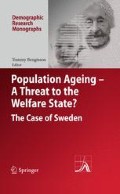Abstract
The process of population ageing that has been occurring in Sweden can be expected to continue during the coming decades, the population pyramid will become increasingly rectangular, and possibly even demonstrate a shrinking base. This will lead to increasing challenges in terms of financing pensions, elderly care and healthcare. These problems will continue for at least the next 30 years with no demographic solution available. Immigration is not likely to offset population ageing to any larger degree, and even dramatic increases in fertility rates would take 25–30 years to have any positive effect. Since increasing tax rates seems unlikely, the most viable solution lies in an expansion of the workforce and the resulting increase of the tax base. If we rely solely on increasing the retirement age to provide the increased hours worked, we would need to raise the minimum retirement age by roughly 5 years until 2050. While this might be possible, it is more likely that the solution lies not in this or any other single measure but in a combination thereof. However, expanding hours worked not only requires incentives but also job opportunities. Thus the policy should aim not only at expanding labour supply side but also labour demand.
Access this chapter
Tax calculation will be finalised at checkout
Purchases are for personal use only
Notes
- 1.
This section is based on the excellent overview in Willis (1994).
- 2.
Fiat currency, or fiat money, is money backed by an authority, usually a government, for use in exchange of goods and services or to pay a debt.
References
AKU (2007) Arbetskraftsundersökningar 1976–2007. Available at http://www.ssd.scb.se/databaser/makro/produktAKU.asp?produktid=AM0401&lang=1&inl=AKU. Accessed 3 Feb 2010.
Andersson, G. (2004). Childbearing after migration: Fertility patterns of foreign-born women in Sweden. International Migration Review, 38(2), 747–775.
Arbejdsmarkedskommissionen. (2009). Velfærd kræver arbejde. Albertslund: Schultz.
Arthur, W. B., & McNicoll, G. (1978). Samuelson, population and intergenerational transfers. International Economic Review, 19, 241–246.
Bengtsson, T., & Scott, K. (2006). Immigrant consumption of sickness benefits in Sweden, 1981–1991. Journal of Socio-Economics, 35, 440–457.
Bennich-Björkman, L., Lundh, C., Ohlsson, R., Pedersen, P., & Rooth, D.-O. (2002). Arbete? Var god dröj! – Invandrare i välfärdssamhället. Stockholm: SNS Förlag.
Bongaarts, J., & Bulatao, R. A. (Eds.). (2000). Beyond six billion. Forecasting the World’s population. Washington, D.C.: National Academy Press.
Coale, A. J. (1957). How the age distribution of a human population is determined. Cold Spring Harbor Symposia on Quantitative Biology, 22, 83–89.
Christensen, K., Doblehammer, G., Rau, R., & Vaupel, J. W. (2009). Ageing populations: the challenges ahead. Lancet, 374, 1196–1208.
Dublin, L. I., & Lotka, A. J. (1925). On the true rate of natural increase. Journal of the American Statistical Association, 20(105), 305–339.
Espenshade, T. (1994). Can immigration slow U.S. population ageing? Journal of Policy Analysis and Management, 13, 759–768.
Forsell, C., Hallberg, D., Lindh, T., & Öberg, G. (2008). Intergenerational public and private sector redistribution in Sweden 2003. Stockholm: Mimeo Institute for Futures Studies.
Jonsson, S. H., & Rendell, M. S. (2004). The fertility contribution of Mexican immigration to the United States. Demography, 41(1), 129–150.
Keyfitz, N. (1968). Introduction to the mathematics of population. Reading, MA: Addison-Wesley.
Lee, R. D. (1994). The formal demography of population ageing, transfers, and the economic life cycle. In L. G. Martin & S. H. Preston (Eds.), Demography of ageing (pp. 8–49). Washington, D.C: National Academy Press.
Lotka, A. J. (1922). The stability of the normal age distribution. Proceedings of the National Academy of Sciences of the United States of America, 8(11), 339–345.
Lundh, C., & Ohlsson, R. (1999). Från arbetskraftsimport till flyktinginvandring. Stockholm: SNS Förlag.
OECD. (2009). OECD employment outlook: tackling the jobs crisis. Paris: OECD.
Oeppen, J., & Vaupel, J. W. (2002). Demography – Broken limits to life expectancy. Science, 296, 1029–1031.
Parker, M. G., & Thorslund, M. (2007). Health trends in the elderly population: Getting better and getting worse. The Gerontologist, 47, 150–158.
Preston, S., Heuveline, P., & Guillot, P. (2001). Demography. Measuring and modeling population processes. Oxford: Blackwell.
Samuelson, P. A. (1958). An exact consumption loan model of interest with and without the social contrivance of money. Journal of Political Economy, 66, 923–933.
Samuelson, P. A. (1975). The optimum growth rate of a population. International Economic Review, 16(3), 531–538.
SOU. (2004). Sveriges ekonomi – utsikter till, 2020 Bilaga 1-2 till Långtidsutredningen. Stockholm: Finansdepartementet.
Statistics Sweden [Statistiska centralbyrån]. (1999). Befolkningsutvecklingen under 250 år. Historisk statistik för Sverige. Demografiska rapporter 1999:2. Stockholm: SCB.
Statistics Sweden [Statistiska centralbyrån]. (2004). Tabeller över Sveriges befolkning. Örebro: SCB.
UN. (2001). Replacement migration. UN Publication ST/ESA/SER.A/206. New York: UN.
Willis, R. J. (1994). Economic analysis of fertility: Micro foundations and aggregate implications. In K. Lindahl Kiessling & H. Landberg (Eds.), Population, economic development and the environment. The making of our common future (pp. 139–171). Oxford: Oxford University Press.
Acknowledgments
We owe a great debt to Thomas Lindh who generously provided us with the data on income and production as well as with valuable comments.
Author information
Authors and Affiliations
Corresponding author
Editor information
Editors and Affiliations
Rights and permissions
Copyright information
© 2010 Springer-Verlag Berlin Heidelberg
About this chapter
Cite this chapter
Bengtsson, T., Scott, K. (2010). The Ageing Population. In: Bengtsson, T. (eds) Population Ageing - A Threat to the Welfare State?. Demographic Research Monographs. Springer, Berlin, Heidelberg. https://doi.org/10.1007/978-3-642-12612-3_2
Download citation
DOI: https://doi.org/10.1007/978-3-642-12612-3_2
Published:
Publisher Name: Springer, Berlin, Heidelberg
Print ISBN: 978-3-642-12611-6
Online ISBN: 978-3-642-12612-3
eBook Packages: Business and EconomicsEconomics and Finance (R0)

